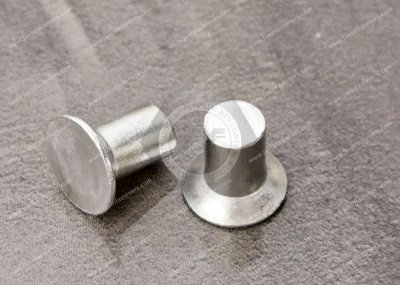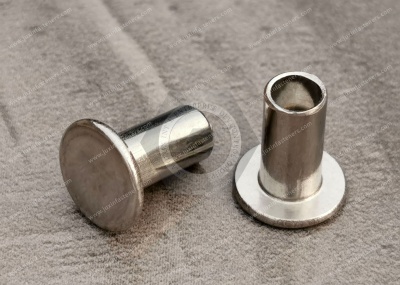Call Us
+86 136 6007 9809
Call Us
+86 136 6007 9809
Nov. 01, 2024
Usage of Flush-Mount Solid Rivets
Countersunk solid rivets are a type of riveted part widely used in mechanical manufacturing, aerospace, construction engineering, and other fields. They are characterized by simple structure, high strength, good corrosion resistance, and strong reliability. This article will introduce the riveting method and precautions for countersunk solid rivets.
Countersunk solid rivets are a commonly used fastener, which is usually made of metal materials and has the characteristics of firmness and durability. Its uses are mainly in the following aspects:
1. Used to fix metal materials: Countersunk solid rivets can join metal plates, pipes, and other parts. Using a special rivet gun or riveter, the rivet is inserted into the material from one side, and then the tail of the rivet is tightened by impact or force to form a solid connection.
2. Used to fix soft materials: Countersunk solid rivets can also be used to fix soft materials such as plastics and rubber. By punching a hole in the material, inserting the rivet into the hole, and then tightening the tail of the rivet by applying force, the rivet is firmly connected to the material.
3. For anti-loosening: Countersunk solid rivets can prevent the connection from loosening. Since rivets have a strong tightening effect, they can also maintain the stability of the connection when vibration or other external forces need to be resisted.
Preparation
1. Material selection: The selection of materials needs to be considered in combination with the occasion and working conditions of riveting.
2. Design: The strength of the riveting area must be considered during riveting to avoid deformation or damage.
Tools: Rivet pliers, drill bits, wrenches, etc.
3. Drilling of rivets
Drilling is required before riveting. Generally speaking, the diameter of the drill hole should be slightly smaller than the diameter of the rivet to ensure that the rivet can be tightly fixed on the workpiece.


Installing rivets
When installing rivets, pay attention to the following points:
1. Confirm the length of the rivet first: To ensure correct installation, the length of the rivet should be slightly larger than the thickness of the riveted part.
2. Insert the rivet: Insert the rivet into the drilled hole and ensure that it is correctly installed in the riveted part.
3. Clamp the rivet: Use the riveting pliers to clamp the rivet and ensure it is fixed correctly in the target area.
V. Riveting of rivets
Before riveting, you need to clamp the rivet head with pliers and tighten the rivet body with a wrench. Then, use the riveting pliers to act on the rivet head until the rivet shrinks and forms a firm connection, thus completing the riveting of the countersunk solid rivet.
VI. Precautions
1. Rivet specifications: Different riveting occasions and working environments require consideration of rivets of various specifications.
2. Riveting area: The riveting area must be firm to avoid falling or disassembly after riveting.
3. Need to maintain stability: Stability must be maintained during the riveting process to avoid affecting the quality of the riveting.
4. Pay attention to strength: During the riveting process, you need to focus on strength control. Excessive force may damage the riveted parts.
5. Quality inspection: After the riveting is completed, a quality inspection is required to ensure that the riveting quality meets the requirements.
VII. Summary
The riveting of countersunk solid rivets is relatively simple, but some details and skills still need to be paid attention to. This article introduces the links of rivet drilling, rivet installation, and riveting in detail, hoping to help readers master the riveting skills of countersunk solid rivets better.
Mil. Spec. Aluminum Flush-Mount Solid Rivets
Aluminum Flush-Mount Solid Rivets
18-8 Stainless Steel Flush-Mount Solid Rivets
Brass Flush-Mount Solid Rivets
Steel Flush-Mount Solid Rivets
Steel Domed Head Solid Rivets
Aluminum Domed Head Solid Rivets
18-8 Stainless Steel Domed Head Solid Rivets
Brass Domed Head Solid Rivets
Copper Domed Head Solid Rivets
18-8 Stainless Steel Flat Head Solid Rivets
Steel Flat Head Solid Rivets
Aluminum Flat Head Solid Rivets
Copper Flat Head Solid Rivets
Brass Flat Head Solid Rivets
Low-Profile Flat Head Solid Rivets
Mil. Spec. Aluminum Low-Profile Domed Head Solid Rivets
Aluminum Low-Profile Domed Head Solid Rivets
Steel Low-Profile Domed Head Solid Rivets
Steel Low-Profile Domed Head Solid Rivets
Hollow Rivets
Pin-Drive Rivets
Nickel-plated steel Split Rivets
Brass Split Rivets
Locking-Collar Rivets
It should be noted that when using countersunk solid rivets, appropriate size and length should be selected according to the specific situation to ensure the firmness of the connection. At the same time, the correct tools and skills must be used when making rivet connections to ensure the safe and effective completion of the connection work.
If you are looking for high-quality Brass Flush-Mount Solid Rivets and fasteners or technical support for structural design, please get in touch with me. Thanks.Email:adelajonly@gmail.com
Website: https://www.juxinfasteners.com
Contact Us
Tel.:
+86 020 8621 0320
+86 020 3121 6067
Technical Support:
Navigation
SEND INQUIREY